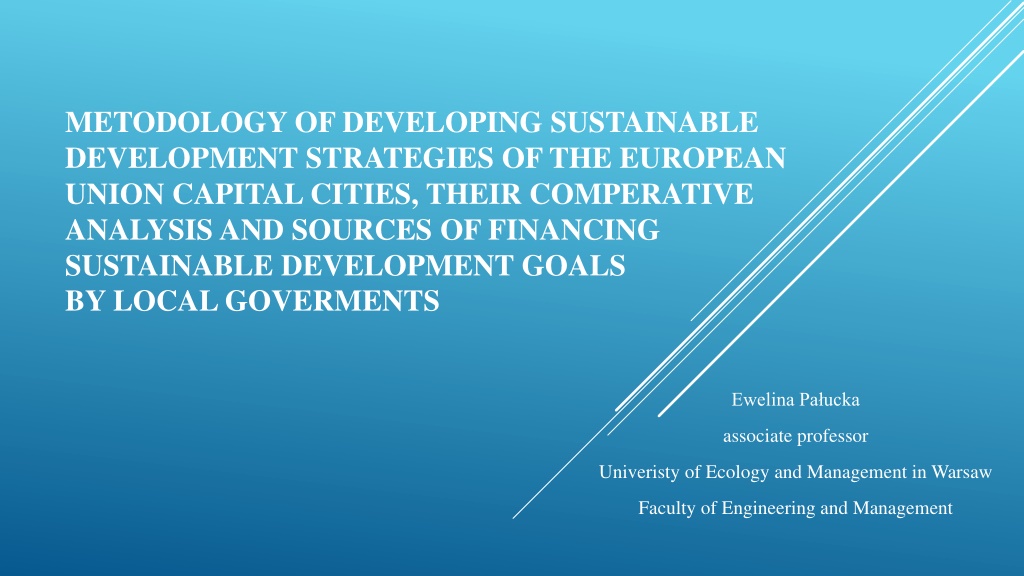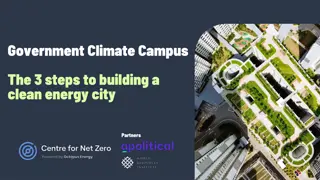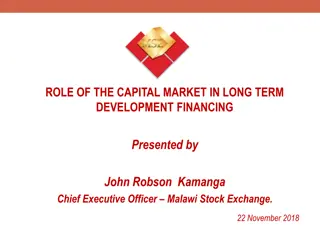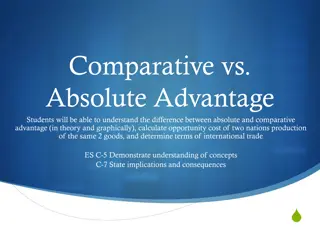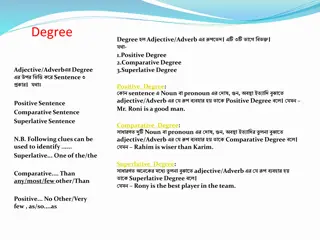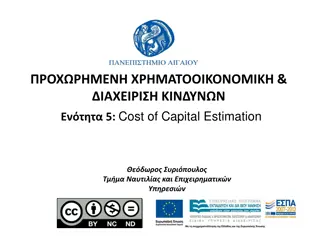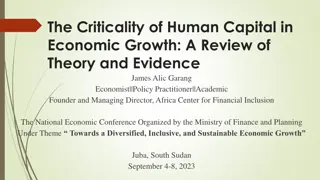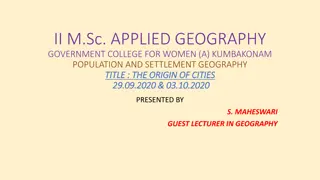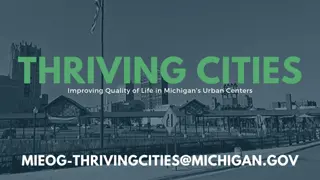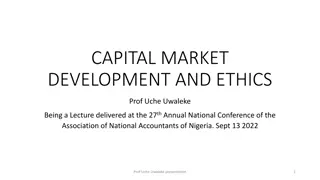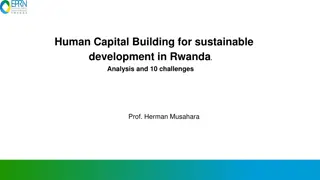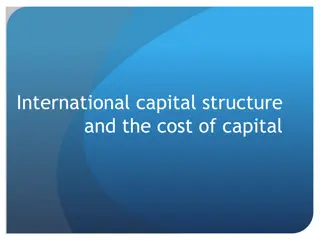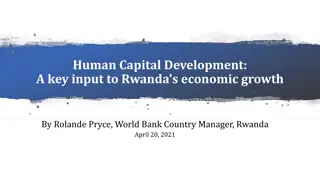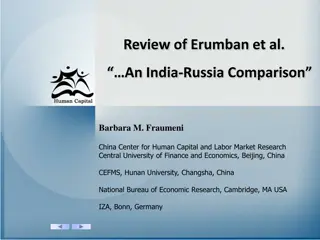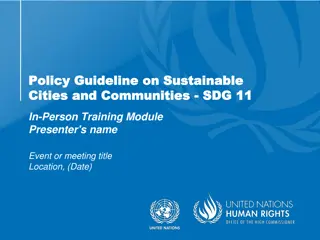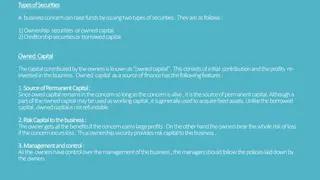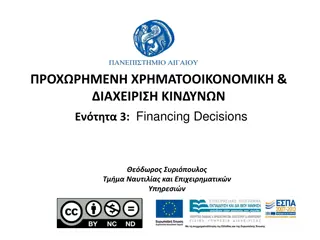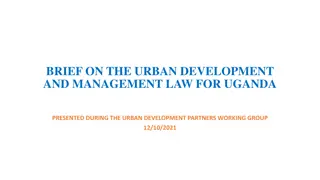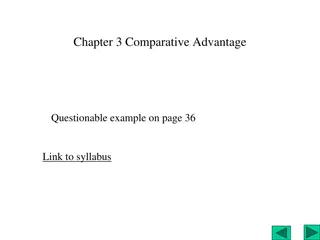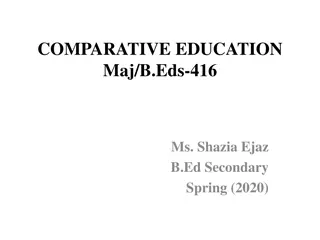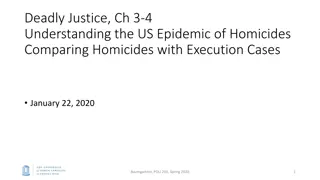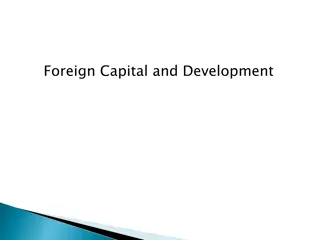Sustainable Development Strategies in EU Capital Cities: A Comparative Analysis
This study delves into the methodologies of developing sustainable development strategies for European Union capital cities, analyzing their comparative elements and exploring sources of financing sustainable development goals by local governments. It encompasses an overview of the concept of sustainable development, theoretical foundations, study materials and methods, analysis of results, and a comprehensive summary.
Download Presentation

Please find below an Image/Link to download the presentation.
The content on the website is provided AS IS for your information and personal use only. It may not be sold, licensed, or shared on other websites without obtaining consent from the author. Download presentation by click this link. If you encounter any issues during the download, it is possible that the publisher has removed the file from their server.
E N D
Presentation Transcript
METODOLOGY OF DEVELOPING SUSTAINABLE DEVELOPMENT STRATEGIES OF THE EUROPEAN UNION CAPITAL CITIES, THEIR COMPERATIVE ANALYSIS AND SOURCES OF FINANCING SUSTAINABLE DEVELOPMENT GOALS BY LOCAL GOVERMENTS Ewelina Pa ucka associate professor Univeristy of Ecology and Management in Warsaw Faculty of Engineering and Management
CONTENT Introduction Theoretical background Study Materials and Methods Analysis and results Summary
CONTENT Introduction Theoretical background Study Materials and Methods Analysis and results Summary
INTRODUCTION overview of the origin of the concept of sustainable development determines core elements and framework of developing SDS tailored for EU capital cities explores the degree of cohesion between uniquely designed SDS with the SDSs of all the EU capital cities presents the sources of financing the sustainable goals of the surveyed cities
CONTENT Introduction Theoretical background Study Materials and Methods Analysis and results Summary
THEORETICAL BACKGROUND Concept of SD known already in ancient Roman, Greek, Egyptian and Mesopotamian civilizations Firstly described by Hans Carl von Carlowitz in 1713 in Sylvicultura Oeconomica Raised significance only in the second half of the 20th century
THEORETICAL BACKGROUND World Commission on Environment and Development s (1987) definition: Sustainable Development is a development that meets the needs of the present without compromising the ability of future generations to meet their own needs Paris Agreement in 2015: 2030 Agenda for Sustainable Development & its 17 Sustainable Development Goals
CONTENT Introduction Theoretical background Study Materials and Methods Analysis and results Summary
STUDY: MATERIALS AND METHODS methodology of developing and determining the core elements of exemplary comprehensive, universal and reliable SDSs with replication possibilities analysis of international literature, publications, SDSs and budgetary acts of all European Union capital cities critical comparative analysis of SDSs of all EU capital cities & cohesion analysis analysis of sources of financing SD goals by the research local authorities
STUDY: MATERIALS AND METHODS based on analysis in stage one: 76 dependent binary variables were defined they reflect complexity, versatility are tools to determine the level of cohesion of the 27 surveyed capital cities SDSs with the exemplary strategy tailored in stage two of the study
Environmental 1. Building management a. Energy efficiency in existing municipal buildings var_ ecol_1_1 b. Energy efficiency in newly built municipal buildings var_ ecol_1_2 c. Usage of green energy in existing municipal buildings var_ ecol_1_3 d. Usage of green energy in newly built municipal buildings var_ ecol_1_4 e. Improving the sustainability of construction of new municipal buildings var_ ecol_1_5 var_ ecol_1_6 f. Improving the sustainability of renovation of buildings 2. Waste management a. Reducing var_ ecol_2_1 b. Reusing var_ ecol_2_2 c. Recycling var_ ecol_2_3 d. Composting bio-waste var_ ecol_2_4 e. Circular resource management var_ ecol_2_5 f. Education into reasonable consumption var_ ecol_2_6 3. Water management a. Preserving water quality incl. drinking water var_ ecol_3_1 b. Preserving water quantity var_ ecol_3_2 c. Combatting the growing risk of flooding var_ ecol_3_3 d. Combatting the growing risk of drought var_ ecol_3_4 e. Maintaining blue mesh allover the surface of the city var_ ecol_3_5
Environ mental Criteria Sub-criteria/ Indicator Binary variable 4. mobility Green personal a. Aid for public transportation var_ ecol_4_1 b. Pricing instruments (distinction between low carbon and traditional transportation) var_ ecol_4_2 c. Optimisation of road usage and traffic management var_ ecol_4_3 d. Parking spaces policy var_ ecol_4_4 e. Zero emission mobility incentives var_ ecol_4_5 f. Promotion of shared transportation (car sharing, car pooling) var_ ecol_4 _6 5. Green city logistics and freight flows a. Minimisation of driven kilometres var_ ecol_5_1 b. Zero emission delivery var_ ecol_5_2 c. Night deliveries var_ ecol_5_3 d. Share inbound transportation with consolidation centres at city boarder var_ ecol_5_4 e. Pick-up points a. Public transportation accessibility and coverage var_ ecol_5_5 var_ ecol_6_1 6. Infrastructure planning b. Pavement network and condition var_ ecol_6_2 c. Bicycle paths network and condition var_ ecol_6_3 d. Municipal bicycles var_ ecol_6_4 e. P+R var_ ecol_6_5 f. creation of car free zones and woonerfs var_ ecol_6_6 g. access limitations in the city centres var_ ecol_6_7 h. bicycle parking var_ ecol_6_8 i. car parks var_ ecol_6_9 j. creation of green public areas var_ ecol_6_10
Environ mental Criteria Sub-criteria/ Indicator Binary variable 7. Energy a. Energy efficiency in local industry var_ ecol_7_1 b. Optimising the conventional energy circuits var_ ecol_7_2 c. Usage of renewable energy sources var_ ecol_7_3 d. Investments in renewable energy sources var_ ecol_7_4 8. Biological diversity in the city a. Preserving the existing one var_ ecol_8_1 b. Developing local biodiversity c. Combating urban heat islands var_ ecol_8_2 var_ ecol_8_3 var_ ecol_9_1 9. authorities sustainable institution Transformation of local more a. Waste management into b. Energy efficiency var_ ecol_9_2 c. Green transportation amongst employees and applicants var_ ecol_9_3 d. Digitalisation var_ ecol_9_4 10. ecological awareness amongst Actions for increased No further sub-criteria var_ ecol_10
Social Criteria Sub-criteria/ Indicator Binary variable 1. Combating poverty amongst citizens 2. Ensuring housing 3. Procurement energy management for citizens No further sub-criteria No further sub-criteria No further sub-criteria var_soc_1 var_soc_2 var_soc_3 4. Combating social exclusion based on gender, age, disabilities, sexual preferences, religion, political views, material status, disabilities, of immigrants and of refugees No further sub-criteria var_soc_4 5. Providing inclusive educational system No further sub-criteria var_soc_5 6. Providing complex care system for young people No further sub-criteria var_soc_6 7. Providing complex care system for elderly people No further sub-criteria var_soc_7 8. Providing complex care system for people with disabilities 9. Ensuring environmental health No further sub-criteria var_soc_8 No further sub-criteria var_soc_9 10. Ensuring safety 11. Accessibility to culture and heritage No further sub-criteria No further sub-criteria var_soc_10 var_soc_11 12. Transparency of local public institutions No further sub-criteria var_soc_12
Economic Criteria Sub-criteria/ Indicator Binary variable 1. Introduction of financial systems incentives a. Municipal taxation system var_econ_1_1 b. Municipal environmental fees var_econ_1_2 c. public aids var_econ_1_3 in order to better adapt it, to render it more coherent and to integrate environmental criteria No further sub-criteria 2. Housing policy including procurement management 3. Supporting leading to SD 4. Investments var_econ_2 innovations No further sub-criteria var_econ_3 a. increase socially responsible investment var_econ_4_1 b. increase investments leading to SD var_econ_4_2 5. supporting local economic stability Maintaining and a. Supporting local industry var_econ_5_1 b. Supporting the local economy through local sourcing var_econ_5_2 c. Promotion of local economy var_econ_5_3 d. Preparing for the emergence of new jobs linked to the transition var_econ_5_4 6. economy 7. financing 8. Sustainable tourism, events and city marketing Promoting circular No further sub-criteria var_econ_6 Providing sustainable No further sub-criteria var_econ_7 No further sub-criteria var_econ_8
STUDY: MATERIALS AND METHODS The level of cohesion of the population of the 27 SDSs of UE capital cities with the exemplary one and on that basis to categorize each outcome in one out of five possible groups representing the level of cohesion: - 70 points and above excellent level - 59 69 points very good level - 48 58 points good level - 37 47 points satisfactory level - 0 36 points non - satisfactory level.
CONTENT Introduction Theoretical background Study Materials and Methods Analysis and results Summary
STUDY: ANALYSIS AND RESULTS THE OVERALL LEVEL OF COHESION OF SDS OF EU CAPITAL CITIES 80 70 60 50 40 30 20 10 0
STUDY: ANALYSIS AND RESULTS Coefficient Value var_av 41,44 var_med 50,00 var_mode 52,00 var_min 4,00 var_max 76,00 var_range 72,00 var_stdev 25,68 N 76
STUDY: ANALYSIS AND RESULTS The overall number of points obtained in each sustainability pillar by 27 EU capital cities Amsterdam 50 12 14 23 2 9 Berlin 47 12 11 4 3 0 Brussels 43 11 13 4 0 1 Budapest 7 3 6 50 12 14 Dublin 15 3 8 48 12 14 Lisbon 26 2 9 19 3 2 Luxembourg 27 11 12 29 12 11 Nicosia 10 0 0 30 12 13 Prague 46 6 11 3 1 2 Rome 35 5 3 4 1 0 Stockholm 45 12 14 31 10 11 Valletta 11 0 1 48 12 14 Vilnius 4 0 0 38 9 5 Zagreb 33 12 13 0 10 20 30 40 50 60 70 80 var_ ecol Total var_soc Total var_econ Total
STUDY: ANALYSIS AND RESULTS The level of cohesion of an exemplary SDS and the ones of 27 EU capital cities within social pillarart var_ ecol_1_1 var_ ecol_10 var_ ecol_1_2 var_ ecol_1_3 var_ ecol_9_4 100% var_ ecol_9_3 var_ ecol_1_4 var_ ecol_1_5 var_ ecol_1_6 var_ ecol_9_2 90% var_ ecol_9_1 80% var_ ecol_8_3 var_ ecol_2_1 var_ ecol_2_2 70% var_ ecol_8_2 60% var_ ecol_8_1 var_ ecol_2_3 50% var_ ecol_7_4 var_ ecol_2_4 40% var_ ecol_7_3 var_ ecol_2_5 30% 20% var_ ecol_7_2 var_ ecol_2_6 10% var_ ecol_7_1 var_ ecol_3_1 0% var_ ecol_6_10 var_ ecol_3_2 var_ ecol_6_9 var_ ecol_3_3 var_ ecol_6_8 var_ ecol_3_4 var_ ecol_6_7 var_ ecol_3_5 var_ ecol_6_6 var_ ecol_4_1 var_ ecol_6_5 var_ ecol_4_2 var_ ecol_4_3 var_ ecol_4_4 var_ ecol_4_5 var_ ecol_4_6 var_ ecol_5_1 var_ ecol_5_2 var_ ecol_5_3 var_ ecol_6_4 var_ ecol_6_3 var_ ecol_6_2 var_ ecol_6_1 var_ ecol_5_5 var_ ecol_5_4
STUDY: ANALYSIS AND RESULTS The level of cohesion of an exemplary SDS and the ones of 27 EU capital cities within social pillar var_soc_1 80% var_soc_12 var_soc_2 70% 60% 50% var_soc_11 var_soc_3 40% 30% 20% 10% var_soc_10 var_soc_4 0% var_soc_9 var_soc_5 var_soc_8 var_soc_6 var_soc_7
STUDY: ANALYSIS AND RESULTS The level of cohesion of an exemplary SDS and the ones of 27 EU capital cities within economic pillar var_ econ_1_1 80% var_ econ_8 var_ econ_1_2 70% 60% var_ econ_7 var_ econ_1_3 50% 40% 30% 20% var_ econ_6 var_ econ_2 10% 0% var_ econ_5_4 var_ econ_3 var_ econ_5_3 var_ econ_4_1 var_ econ_5_2 var_ econ_4_2 var_ econ_5_1
STUDY: ANALYSIS AND RESULTS 100% Representation of each binomial variable 90% 80% 70% 60% 50% 40% 30% 20% 10% 0%
STUDY: ANALYSIS AND RESULTS analysis of sources of financing applied by local governments of 27 EU capital cities in order to cover the costs of investments and transition into more sustainable environment: 100% of the analyzed cities present in their budget acts as the main source of financing sustainable transition EU support : - for the European Green Deal for which the European Commission has pledged to mobilise at least 1 trillion in sustainable investments over the decade- Operational Programme Environment (OPE) to support the preservation and the protection of environment, climate change adaptation, and risk prevention and management - Integrated Regional Operational Programme (IROP) to contribute to the promotion of quality of life and to ensure sustainable provision of public services, - Operational Programme Transport (OPT) for the years 2021-2027 with priorities of developing and improving linear transport infrastructure (incl. cities and their hinterlands), introducing modern technologies for the organization of transport and reduction of traffic burden and increasing the utilization and availability of alternative fuels in transport -
STUDY: ANALYSIS AND RESULTS analysis of sources of financing applied by local governments of 27 EU capital cities in order to cover the costs of investments and transition into more sustainable environment: - 74% (20 of the surveyed cities) declared using Clean Mobility Development action program for the purchase of vehicles (electric buses and hybrid vehicles for public transport), as well as the construction of relevant charging infrastructure - 10 out 27 EU capital cities (37% of the population) has a possibility of financing the SD projects with the use of Modernisation Fund - a financial instrument which is set up in 10 lower-income EU member states - almost 30% of the population cities (8 of 27) declare financing their sustainable development from Recovery and Resilience Fund unified EU green classification system - 'TAXONOMY' was created to determine if an economic activity is environmentally sustainable based on harmonised EU criteria
STUDY: ANALYSIS AND RESULTS cooperation of private and public investments to: - scale up sustainable finance to plug the current investment gap, - ensure compatible markets for sustainable financial assets across borders and avoid fragmentation, - achieve economies of scale by exploring synergies, - maximise the impact of EU investment to support our industry and help us deliver on our core priorities. -orienting private capital to more sustainable investments require a comprehensive rethinking of how our financial system works.
STUDY: ANALYSIS AND RESULTS Examples of private and public cooperation in SD finance: - European Union's Capital Markets Union (CMU) project - International Platform on Sustainable Finance Platform - Warsaw Sustainable Segment on Warsaw Stock
CONTENT Introduction Theoretical background Study Materials and Methods Analysis and results Summary
SUMMARY The survey allowed to create methodology of developing and propose core elements of universal, exemplary, comprehensive and replicable SDS for EU cities diversity in the field of constructing the SD strategies within the population of EU capital cities is very high the main sources of finance concentrates around EU programs within the whole population of the survey
